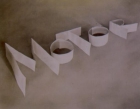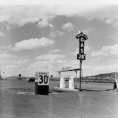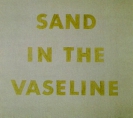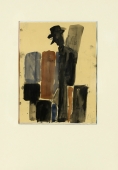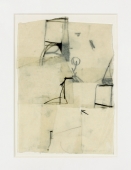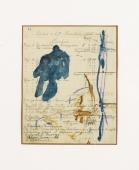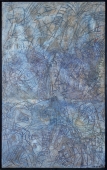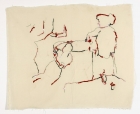
Artist | Edward Ruscha (*1937)
Alias: Edward Ruscha [Ed Ruscha, Edward Rusha]
https://www.artist-info.com/artist/Edward-Ruscha
Biography
Biography
born in 1937 in Omaha, Nebraska
About the work (english / deutsch) Twentysix Gasoline Stations
About the work (english / deutsch) Twentysix Gasoline Stations
„Twentysix Gasoline Stations“ documents in unspectacular photographs, apparently without any artistic standpoint, 26 gasoline stations along Route 66. „I do like facts ... all my books deal with facts and collecting of facts," he once stated (From an interview with Ultra Violet quoted in: Jane Livnigston and Maurice Tuckman, 11 Los Angeles Artists, catalogue fpr the Arts Council of Great Britain, Hayward Gallery, 1971) in answer to the question why he had made such laconic books. The first book was prompted by a pun. „The title came before I even thought about the pictures. I like the word ‘gasoline’ and I like the specific quality of ‘twenty-six’." (John Coplans, Edward Ruscha Discusses His Perplexing Publications, in: Artforum, February 1965, pp. 24-5) „If you look at the book, then you will see how well the typography plays along - I had worked it out before I took the photos .... The book is therefore not a collection of artistic pictures, but the photographs have the meaning of technical statements as in industrial photography." (Camera, 51/1972, No. 2; p. 34) Elsewhere he said: "l wanted to make a book, and I let photography be a secondary medium, an excuse to make a book. That’s what I wanted to do most of all, really, to make a book, not necessarily to take photographs. I wanted to make the book." (From an interview with Walter Hopps in: Edward Ruscha: Romance with Liquids. Paintings 1966-1969, New York, 1993, p.101)
Naturally, the photos taken in 1962 are far more than just a collection of sober artistic facts or technical data. With the benefit of over 30 years’ hindsight, we can well see what Ruscha pin-pointed with his „snapshots" ("For me they are simply snapshots," he stated in Camera, 51/1972, No.2, p.34). Even if Ruscha originally only intended to create something which "formed a clear context“, the photos of the gasoline stations have in the meantime become icons of Pop Art.
The 48-page book „Twentysix Gasoline Stations“ was published by the author under the logo „A National Excelsior Publication" in an edition of 400 copies. Later, further issues followed. (First Edition, 1963, 400 numbered copies; Second Edition 1967, 500 copies; Third Edition, 1969, 3000 copies) Asked what criteria he uses when choosing the subject matter, Ruscha once answered that unlike Monet he could not take the Seine as his motif, "I've just got US 66 between Oklahoma and Los Angeles." (See E.Ruscha: Romance with Liquids, Paintings 1966-69; New York, 1993, p. 100) The first pictures of words (SWEETWATER, DUBLIN, VICKSBURG), which Ruscha painted at that time, name specific places which had a special meaning in terms of his biography. They were all places whose names had struck him while hitchhiking through Florida. Ruscha’s decision to opt for gasoline stations as a motif is a decision in favor of a vital, symbolic language. With their powerful signs, the gas stations protest against a boring architecture of good taste of the day which appeared overly artificial. Like other Pop artists, Ruscha taps unknown visual spaces by incorporating the everyday, the all-too familiar, the apparently banal.
Nowadays, the meaning of gasoline stations has changed; they have since become a symbol of the unfulfilled American dream. Jim Jarmusch’s film „Stranger Than Paradise“, made in 1984 shows this in compelling black-and-white pictures, which appear related to those used by Ed Ruscha, if with a different intent. In the opening scene the camera follows a walker, who „slowly walks along past triste tenements, lowered window shutters sprayed with paint, trashcans and ultimately also a corner gasoline station ..., at which cars and, if hardly recognizable, a lonely gas station attendant stand." (Bernd Polster, Super oder Normal, Tankstellen - Geschichte eines modernen Mythos, Cologne 1996, p. 174) The inscription at the gasoline station reads: "Quality You Can Trust“.
Twentysix Gasoline Stations
„Twentysix Gasoline Stations“ dokumentiert in unspektakulären Fotografien, scheinbar ohne jede künstlerische Attitüde, 26 Tankstellen entlang der Route 66. „Ich mag Tatsachen ... all meine Bilder beschäftigen sich mit Tatsachen und dem Sammeln von Fakten“ (Aus einem Interview mit Ultra Violet zitiert in: Jane Livingston and Maurice Tuckman, 11 Los Angeles Artists, catalogue for the Arts Council of Great Britian, the Hayward Gallery, 1971), hat Ruscha einmal auf die Frage geantwortet, warum er derart lakonische Bücher gemacht habe. Anstoß zu diesem ersten Buch gab ein Wortspiel. „Ich hatte den Titel bevor ich überhaupt an die Bilder gedacht hatte. Ich mag das Wort 'gasoline’ und ich mag die besondere Qualität von 'twentysix’.“ (John Coplans, "Edward Ruscha Discusses His Perplexing Publications," in: Artforum, February 1965, S. 24-25) „Wenn Sie das Buch anschauen, dann sehen Sie, wie gut die Typographie spielt - ich habe Sie ausgearbeitet, bevor ich die Photos aufnahm. ... Das Buch ist deshalb keine Sammlung von künstlerischen Bildern, sondern die Aufnahmen haben die Bedeutung technischer Angaben wie in der Industriephotographie.“ (Camera, 51/1972, Nr. 2; S. 34) Und an anderer Stelle: „Ich wollte ein Buch machen und benutzte die Fotografie als zweitrangiges Medium, als eine Entschuldigung, um ein Buch zu machen. Am wichtigsten war es mir tatsächlich ein Buch zu machen und nicht zu fotografieren. Ich wollte das Buch machen.“ (Aus einem Interview mit Walter Hopps in: Edward Ruscha: Romance with Liquids, Paintings 1966 - 1969, New York 1933, S. 101)
Natürlich sind die 1962 aufgenommenen Fotografien weit mehr als eine Sammlung nüchterner bildnerischer Fakten oder technischer Angaben. Aus dem Abstand von über 30 Jahren läßt sich gut erkennen, was Ruscha damals mit seinen „Schnappschüssen" ("Für mich sind es einfach Schnappschüsse.", Camera, 51/1972, Nr. 2; S.34) auf den Punkt gebracht hat. Auch wenn Ruscha ursprünglich nur vorhatte, etwas zu gestalten, was „einen festen Zusammenhang ergab“, (op.cit.) wurden die Fotografien der Tankstellen mit der Zeit zu Ikonen der Pop Art.
Das 48 Seiten umfassende Buch „Twentysix Gasoline Stations“ erschien im Selbstverlag unter dem Logo „A National Excelsior Publication“ in einer Auflage von 400 Exemplaren. Später folgten weitere Ausgaben (1.Ausgabe, 1963, 400 nummerierte Exemplare; 2. Auflage, 1967, 500 Exemplare; 3. Ausgabe, 1969, 3000 Exemplare). Nach den Kriterien für die Wahl seiner Sujets befragt, hat Ruscha einmal geantwortet, er habe ja nicht wie Monet die Seine als Motiv nehmen können, „Ich habe nur die US 66 zwischen Oklahoma und Los Angeles.“ ((op.cit. E.Ruscha, Romance with Liquids, S. 100) Auch die ersten Schriftbilder (SWEETWATER, DUBLIN, VICKSBURG), die Ruscha in jener Zeit malte, benennen Plätze, die in seiner Biographie eine bestimmte Bedeutung hatten. Alles Orte, deren Namen ihm während einer Reise per Anhalter durch Florida aufgefallen waren.
Ruschas Entscheidung für die Tankstellen als Motiv ist eine Entscheidung für eine vitale Symbolsprache. Mit ihren kraftvollen Zeichen protestieren sie gegen eine langweilig und angestrengt wirkende Architektur des guten Geschmacks. Ruscha erschließt - wie andere Pop Art Künstler auch - durch die Einbeziehung des Alltäglichen, des allzu Vertrauten, des scheinbar Banalen, unerkannte visuelle Räume.
In unseren Tagen hat sich die Bedeutung der Tankstellen geändert, sie hat sich zu einem Symbol des unerfüllten amerikanischen Traums gewandelt. Jim Jarmuschs Film „Stranger Than Paradise“ von 1984 zeigt dies in eindringlichen Schwarzweißbildern, die - mit anderen Vorzeichen - denen von Ed Ruscha verwandt zu sein scheinen. In der Eröffnungsszene folgt die Kamera einem Spaziergänger, der „langsam an tristen Mietskasernen, heruntergelassenen und besprühten Schaufensterläden, Mülltonnen und schließlich auch an einer Eck-Tankstelle ... entlangstreift, auf der Autos und, kaum zu erkennen, ein einsamer Tankwart stehen.“ (Bernd Polster, Super oder Normal, Tankstellen - Geschichte eines modernen Mythos, Köln 1996, S. 174) Die Aufschrift an der Tankstelle sagt: „Quality You Can Trust“.
German text by Andreas Bee / Translation by Jeremy Gaines
(Extract - Full printed version available in the Museum)
MMK - Museum für Moderne Kunst, Frankfurt am Main
About the work (english / deutsch) Motor / Plenty Big Hotel Room
About the work (english / deutsch) Motor / Plenty Big Hotel Room
In Ruschas pictures of writing that have arisen roughly since the mid-Sixties, he generally places names or simple buzz words on a colored background. The usually sober clear typography Kontrasts sharply with the frequently ambivalent words or concepts. Here, language produces associations and calls for interpretation. Language is a basic communications system used to render notions more precise. At the same time, it is also an open significative system that requires an indivldual interpretation. Painting and language dialectically question one another. Where the color of picture directs attention towards specific contents or associations, the concepts in the works usually create other connotations. The concepts in Ruschas pictures really get under the viewer's skin: Language in Ruschas society, and thus unsettle our perceptual structures, as these are geared to objectivity.
For the Frankfurt exhibition, the following pictures have been grouped together to form an important group: Securing the Last Letter ("Boss"), made in 1964, Plenty Big Hotel Room (Painting for The American lndian) made in 1985, Drugs, Hardware, Barber, Video, made in 1987, and the 1989 re-edition of the first of Ruschas photo series, the 1962 Gasoline Stations, as well as Trademark Study 5, made in 1962, and Motor, made in 1970; the latter two drawings are on view in a special room featuring drawings by various artists from the Whitney Museum collection. Whereas his early works were all produced using painting (color) and language (text), in the two more recent pictures Ruscha no longer writes out the concepts given in the titles, but replaced these with black or white blank spaces, thus ensuring that the meanings more or less fixed by the words become open conceptual fields. In this manner, for example in Plenty Big Hotel Room, a picture arises with an associative basis roughly defined by the title which the viewer can then interpret and fill out with meaning as slhe sees fit In the context of the history of the persecution of the Native Americans, driven from their land, the star-spangled banner becomes a questioned and criticized symbol of humanity and liberty.
Motor / Plenty Big Hotel Room
In den Schriftbildern Ruschas, die seit Mitte der sechziger Jahre entstanden, stehen Namen oder einfache Reizworte auf einem subtil mit natürlichen Farbstoffen gemalten Bildgrund. Die meist nüchterne, klare Typographie der Schrift steht dabei in einem bewußten Gegensatz zu den oft vieldeutigen Worten oder Begriffen. Sprache ruft Assoziationen hervor und verlangt nach Interpretation. Sie dient als Kommunikationssystem einerseits zur Präzisierung von Sachverhalten, andererseits ist sie aber auch offen für Bedeutungen, die der Auslegung durch das Individuum bedürfen. Malerei und Sprache hinterfragen sich in den Werken dialektisch. Führt etwa die Farbigkeit eines Bildes hinzu einem bestimmten Inhalt oder Eindruck, so rufen die - oft drastischen und anrührenden Begriffe in den Werken meist andere Konnotationen hervor. Sprache hinterfragt bei Ruscha somit vor allem festgelegte und scheinbar objektive Bedeutungen unserer optischen Wahrnehmungen.
Für die Frankfurter Ausstellung konnten folgende Werke zu einer Gruppe verbunden werden: Securing the Last Letter ("Boss"), aus dem Jahr 1964, Plenty Big Hotel Room (Painting for The American Indian), von 1985, Drugs, Hardware, Barber, Video (1987) und das nach der 1962 entstandenen ersten Fotoserie im Jahr 1989 neuaufgelegte Portfolio Gasoline Stations. Hinzu kommen in einem gesonderten Raum, in dem Zeichnungen verschiedener Künstler aus dem Whitney Museum zusammengestellt wurden, die Arbeiten Trademark Study 5 (1962) und Motor (1970). Während die früheren Werke alle mit den geschilderten Mitteln der Malerei (Farbe) und der Sprache (Text) arbeiteten, ging Ruscha in den beiden jüngeren Bildern dazu über, die in den Titeln angegebenen Begriffe nicht mehr in Schrift wiederzugeben, sondern diese durch schwarze oder weiße Leerstellen zu ersetzen, um die in den Worten mehr oder weniger festgelegten Bedeutungen zu offenen Begriffsfeldern werden zu lassen. In der Folge entsteht - etwa in Plenty Big Hotel Room - ein Bild, das den Assoziationsmöglichkeiten des Betrachters nur noch durch seinen Titel die Richtung weist und ihm damit sehr viel größere Freiheiten für individuelle Interpretationen läßt. Die Leerstellen werden gleichwohl zu einer imaginären Anklageschrift und Kritik an gesellschaftspolitischen Entwicklungen in Amerika. Die amerikanische Nationalflagge wird im Kontext der Geschichte der aus ihrem Land vertriebenen und verfolgten Indianer zu einem hinterfragten, kritisierten Symbol der menschlichen Freiheit.
German text by Rolf Lauter / Translation by Jeremy Gaines
(Extract - Full printed version available in the Museum)
MMK - Museum für Moderne Kunst, Frankfurt am Main
 offers / Requests offers / Requests  |
Learn more about this service |
|---|
 Exhibition Announcements Exhibition Announcements  |
About this service |
|---|
 Visualization |
Learn more about this service | ||
|---|---|---|---|

Interested in discovering more of this artist's networks?
3 easy steps: Register, buy a package for a visualization, select the artist.
See examples how visualization looks like for an artist, a curator, or an exhibition place: Gallery, museum, non-profit place, or collector.

Exhibition History

|
SUMMARY based on artist-info records. More details and Visualizing Art Networks on demand. Venue types: Gallery / Museum / Non-Profit / Collector |
||||||||||||
| Exhibitions in artist-info | 399 (S 100/ G 299) |
Did show together with - Top 5 of 3470 artists (no. of shows) - all shows - Top 100
|
||||||||||
| Exhibitions by type | 399: 200 / 123 / 72 / 4 | |||||||||||
| Venues by type | 230: 94 / 80 / 52 / 4 | |||||||||||
| Curators | 167 | |||||||||||
| artist-info records | Sep 1962 - Oct 2024 | |||||||||||
|
Countries - Top 5 of 16 United States (222) Germany (60) United Kingdom (22) Switzerland (17) France (13) |
Cities - Top 5 of 92 New York (133) Los Angeles (47) London (21) San Francisco (13) München (11) |
Venues (no. of shows )
Top 5 of 230
|
||||||||||
Curators (no. of shows)
Top 5 of 167
|

Ed Ruscha - Now Then |
||||||
| Los Angeles County Museum of Art - LACMA | S | Apr 2024 - Oct 2024 | Los Angeles - La Brea / Beverly | (107) | +0 | |

Vedo Rosso - Collezione Giancarlo e Danna Olgiati |
||||||
| Museo d'arte della Svizzera italiana Lugano - MASI | G | Mar 2022 - Jun 2022 | Lugano | (11) | +0 | |

Earth Beats |
||||||
| Kunsthaus Zürich | G | Oct 2021 - Feb 2022 | Zürich | (664) | +1 | |
| Hug, Cathérine (Curator) | +0 | |||||
| Gianfreda, Sandra (Curator) | +0 | |||||

MONUMENTality |
||||||
| J. Paul Getty Museum | G | Dec 2018 - Apr 2019 | Brentwood / Westwood | (36) | +0 | |

1968. Sparte rêve d’Athènes |
||||||
| Château de Montsoreau-Musée d’art contemporain | G | Jul 2018 - Oct 2018 | Montsoreau | (7) | +0 | |

Ed Ruscha - Course of Empire |
||||||
| The National Gallery | S | Jun 2018 - Oct 2018 | London | (26) | +0 | |
| Keep reading |













